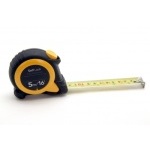- < Experiment 33
-
Experiment 34 v2
- Index >
Creating a Domino Trail

Can you arrange dominoes to fall in the longest trail?
Purpose
This experiment gives children an opportunity to practice measuring and creating simple formulas.
The child will learn how to calculate the maximum distance that can be covered by toppling a given number of dominoes.
You need to know
- how to measure lengths accurately
You will need




Steps
- Find a flat level surface.
- Gather the equipment you need. You can use alternatives to dominoes if you don't have them, but make sure to use something where the items have identical sizes and masses.
- Arrange ten of your dominoes so that if you knock one over all the others will follow. Arrange them to leave the longest trail possible.
- When all ten dominoes are in place, knock the first one down to start the falling dominoes chain reaction. Remember that you are only allowed to touch the first domino.
- If the dominoes stop falling in the middle of the process, rearrange them again. Only when all dominoes have fallen can you move to the next step.
- Measure the length of the fallen dominoes trail.
- Restart the experiment if you think you can still come up a longer trail.
- Write down the longest distance you achieved.
- Estimate the longest distance you could get with twenty dominoes.
- Use twenty dominoes and measure the actual longest distance you can achieve.
Questions
- What would result into a longer trail, a straight trail or one with curves?
- Did you always use the same space between dominoes? How did you come up with your spacing?
- If the number of dominoes you have is N, can you work out a formula for the maximum length of the trail?
Expected answers
-
It is more likely that dominoes arranged in straight lines would result in longer trails than those with curves. Dominoes falling on a straight line would pass momentum more efficiently that those not perfectly aligned, allowing them to be spaced further, and they would still be able to knock the next domino down in the desired direction.
-
It is important that the dominoes are uniformly spaced. In order to come up with the right spacing, the child must do some initial testing to determine what the maximum space is that will allow one domino to knock down the next one.
-
The exact formula will change depending on the size of dominoes being used and what the child has calculated to be the best spacing. The result will probably look like this: distance = (A × N) + B for some values of A and B where A is the distance between dominoes plus the thickness of a domino, and B is the difference between A and the height of a domino.
It would be a good idea to test the formula against the existing runs with ten and twenty dominoes, as well as against some more attempts with different values of N (e.g. N=1, N=2 and N=28).
If you plot these results on a scatter graph (distance on the Y-axis and number of dominoes on the X-axis) then you should get a straight line. The point where the line crosses the Y-axis will give the value for B and the gradient will give the value for A.
Explore further (optional)
- The distance from London to Edinburgh is 535.3 km. How many dominoes would you need to cover this distance?
- Can you find a formula for the time it takes the dominoes to fall based on the number of dominoes.
Tips for further exploration
-
You need to rearrange the formula to get the number of dominoes from the distance.
Suppose your formula is distance = (A × N) + B.
Then you can rearrange this to N = (distance - B) ÷ A.
It is important that you convert distance to the same units you used before (probably centimetres or millimetres).
In practice, B will be so small compared with distance that it probably won't affect the result, so you could just use N = distance ÷ A.
You cannot have part of a domino, so you must round the number up to the next whole number.
- This is more challenging because it is harder to measure these times. Because of this, it might be helpful to use several sets of dominoes and create a really long chain, and then use the results from that to calculate the expected times of shorter chains.



